Sunday Apr 20, 2025
Sunday Apr 20, 2025
Tuesday, 21 March 2023 01:12 - - {{hitsCtrl.values.hits}}
By Great Place to Work in Sri Lanka
Manufacturing and Production (M&P) for the domestic and international market has long played a pivotal role in Sri Lanka’s economic output. The World Bank estimates the manufacturing sector’s contribution to Sri Lanka’s GDP to average around 18%. Central Bank of Sri Lanka Report for 2021 estimates it at 16.1%. While apparel and textiles are the largest segments, the industry mainly extends to rubber, plastic, fabricated metal, food and beverage, and chemical products.
Sri Lanka’s geographic location and economic structure have allowed for pursuit of niche opportunities as a vital component in supply chains or as an alternative manufacturing site. An emphasis on export orientation to earn foreign revenue has led to a focus on facilitating greater productivity and job creation. Solid educational and vocational skill training have allowed the Sri Lankan labour force to be known for its ability to learn fast, quickly adapt and deliver superior results demanded by clients. A reputation for high quality has been built for Sri Lankan products along with an emphasis on corporate social responsibility (CSR).
The apparel export sector caters to producing mid to high end goods for developed countries requiring complex design, manufacturing procedures and high-quality regulation. M&P companies strive to maintain standards for labour rights, factory safety, ethical procurement, and sustainable practices. While these practices boost social advantages, they also enhance the end product.
However, Sri Lanka is home to a relatively smaller population and even smaller workforce. Therefore, labour shortages remain a challenge for the sector. The issue is aggravated by the increasing preference for ‘desk jobs’ and skilled workers migrating for higher paid jobs. Thus, organisations in the sector need to invest in creating a workplace culture that maximises the human potential available and allows them to attract and retain key talent in Sri Lanka.
In light of this and the importance of the industry Great Place to Work conducted a study into people practices and employee perception around workplace culture of the Manufacturing and Production sector in Sri Lanka.
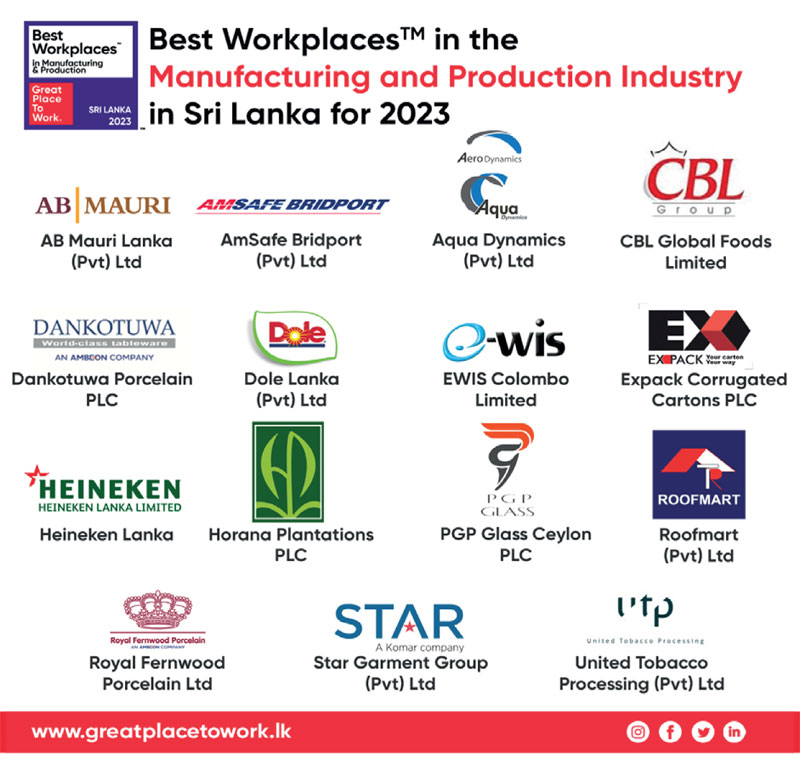
Study summary
During this year’s study cycle, over 27,300 employees from across 45 organisations in the Manufacturing and Production (M&P) industry were surveyed with an average response rate of 85%. This study data helped to determine the 15 Best Workplaces in the manufacturing and production industry and understand the differentiating factors between the best vs. the rest. A summary of findings is provided in this article.
Methodology for selecting the Best Workplaces
Great Place to Work is the globally recognised authority on studying and identifying Best Workplaces. Over the past 30+ years it has studied Great Workplaces and expanded its reach to over 150 countries and territories. Organisations utilise services to benchmark, understand key strengths and areas to improve on and act to drive workplace culture that supports organisational performance. The Sri Lankan study is based on the global model and a rigorous methodology, which has been researched, tested, and carried out in similar studies worldwide. This study was conducted for organisations assessed between March 2022 and March 2023.
The selection follows the global ‘Great Place to Work For All’ methodology. 85% of the evaluation is based on the experience of trust and employees reaching their full human potential as part of their organisations – no matter who they are or what they do. These experiences are analysed in relation to each company’s size, workforce demographics and industry norms. The remaining 15% of the evaluation is based on all employees’ daily experiences of innovation, their organisations’ values, and the effectiveness of their leaders to ensure a consistent positive experience.
The measurement tool used to assess workplace culture is based on two lenses; Firstly, the Trust Index© employee perception survey is conducted to understand the employee workplace experience and constitutes 75% of the total organisation score. In Sri Lanka, only organisations certified (for a period of 1 year) as a great workplace with more than a 70% minimum positive employee perception are considered for Best Workplaces studies in that year.
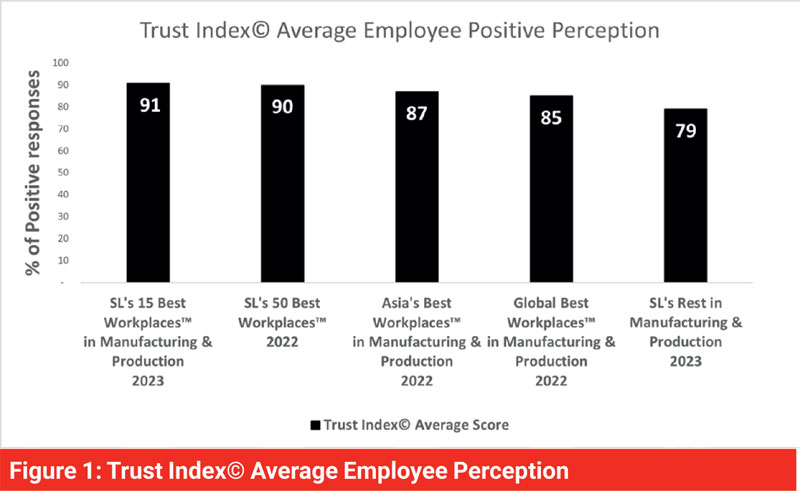
Organisations are measured on whether employees Trust the people they work for, have Pride in work they do and share Camaraderie among people they work with. Secondly, the practices and processes in place to drive the employee experience are evaluated through a central submission termed the Culture Audit which constitutes the remainder 25% of the total score. Results for each of the listed organisations are audited to maintain accuracy and validity of its inclusion in the Best Workplaces List.
Results overview
Figure 1 compares the Trust Index (TI) average employee positive perception which is a measure of the average positive perception of employees. The TI was measured across 58 core global statements and provides an ‘analytical viewpoint’ of an employee.
It is noteworthy that while M&P employees of participating organisations in Asia (87%) and globally (85%) are highly positive about their workplace culture, positive perception among Sri Lankan employees of the Best 15 are even higher (91%). A significant 12% point difference between the Best 15 vs. the Rest of the organisations in the study, shows the average range in employee experience and space for improvement.
Key focus areas
Figure 2 illustrates the 5 key focus areas measured by the Trust Index employee perception survey (Refer methodology). While fairness scores the lowest, pride scores highest across national and global data. It is observed that this is the norm across all industries, including M&P.
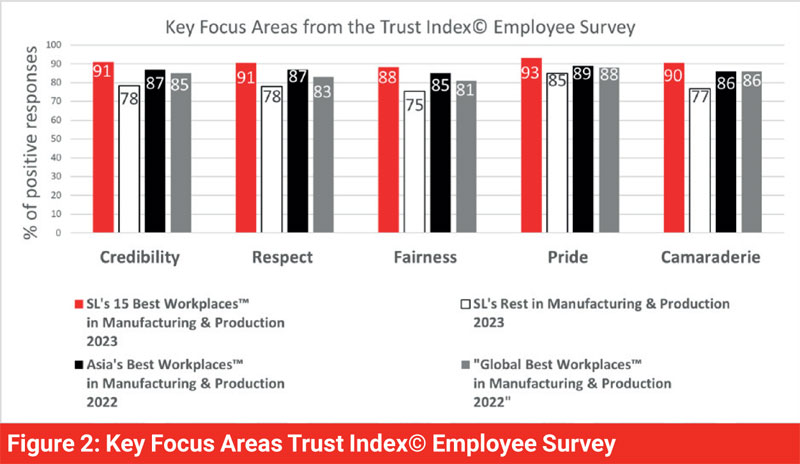
Where the Best 15 outperform the Rest
Figure 3 showcases the highest gap between the Best 15 and the Rest, comparing the top differences in the survey.
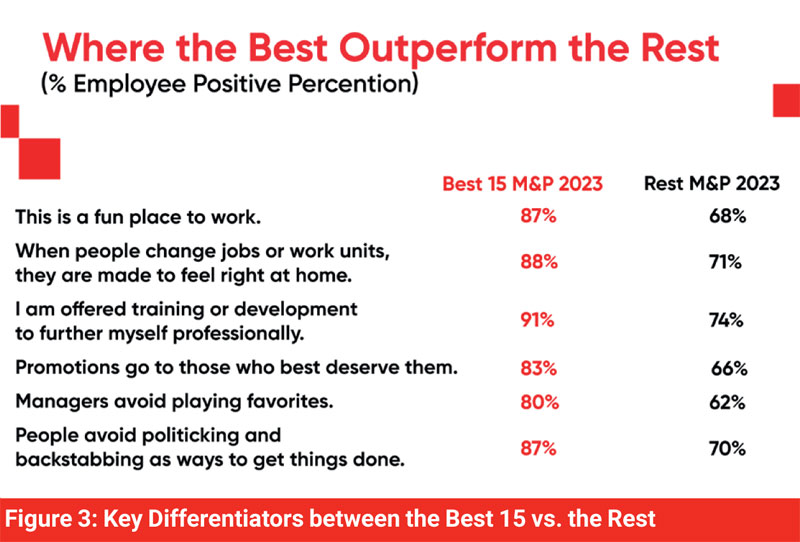
While these are not the highest scoring areas, The Best seem to maintain better perception among employees around community camaraderie, opportunities for training and development and fair behaviour in the work environment in comparison to employees of the Rest. This stems from having the right practices in place and people managers displaying positive behaviour.
Health indices for organisational culture
Figure 4 highlights the key indices of a healthy organisational culture and being a ‘Great Workplace For All’.
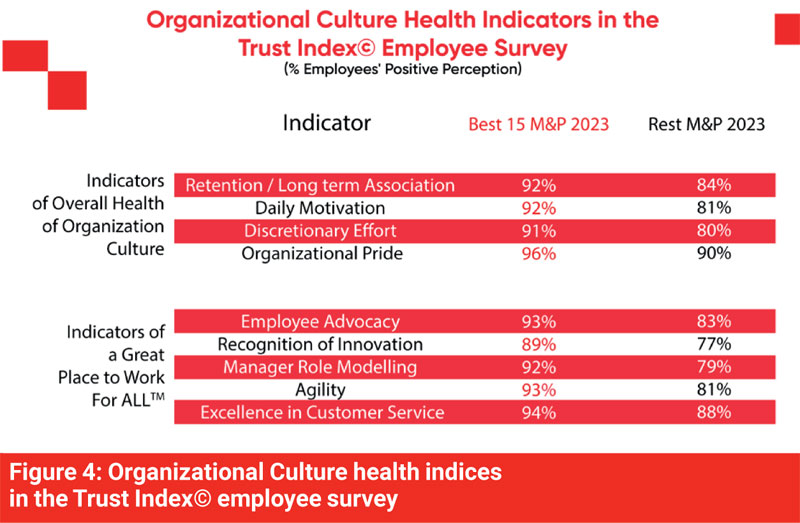
The Best take a significant lead over the rest in the pivotal areas that showcase a foundation of trust. As the M&P segments are crucial to the country’s economy and representation of the country in the global scenarios and economies, a motivated human capital showing high levels of discretionary effort is an invaluable asset to any organisation in the M&P arena and contributes to resilience of the organisation in the face of macroeconomic pressures.
Key drivers of the workplace
Key Drivers are the specific areas from the Trust Index employee survey that are most correlated to employees believing their workplaces as great and contributing to high performance culture. Perception in these areas drive the long-term employee bond with the organisation. The no. 1 driver for employees of these Best 15 is perceiving senior managers as role models reflecting the company values and acting ethically. The other drivers are having facilities that contribute well, a welcoming atmosphere and unique benefits for employees.
A key output of maximising human potential: Innovation by All
Innovation, to any workplace, denotes the creativity in ideation, transformative technology and efficient processes that are continuously developing over time to deliver on high quality of service and products. At its core, it is formulated through management of human capital with inputs of diversity and inclusion of perspectives and ideas, soft skill accumulation and utilisation of employees’ tacit knowledge in decision making and driving operational efficiencies. With the new norms, post the pandemic effect, the work innovation has surely taken to be many meanings to suit any exigency and immediate requirement. The M&P sector organisations will do well to understand the importance of a dynamic workplace culture and implement schemes to continuously upgrade their systems and processes and upskill their human capital.
As Innovation in the long-term is driven through maximising human potential M&P organisations need to recognise the opportunity and expand R&D from a single department to a more commonplace workplace phenomena to help increase competence and agility to stay competitive and resilient in a VUCA world. The Great Place to Work survey tool includes statements that measure the roots of an Innovative workplace culture as shown in Figure 5.
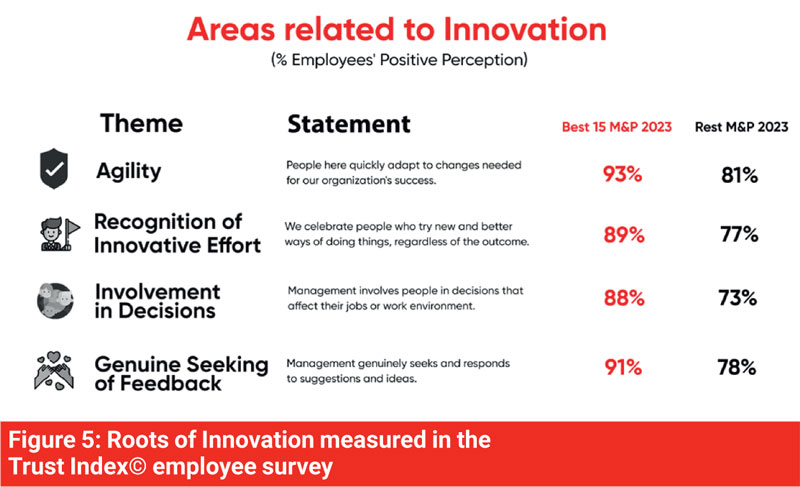
Striving for excellence: Areas for improvement
Analysis of the data from the study found Pride in the organisation (B 94%, R 85%), Good facilities (B 93%, R 81%), and employee cooperation (B 94%, R 87%) to be the areas of highest perception among the employees of the Best 15. Since the Rest also relatively score high in these areas, they are not differentiators. Conversely, Figure 6 showcases the areas where even the Best 15 require improvement.
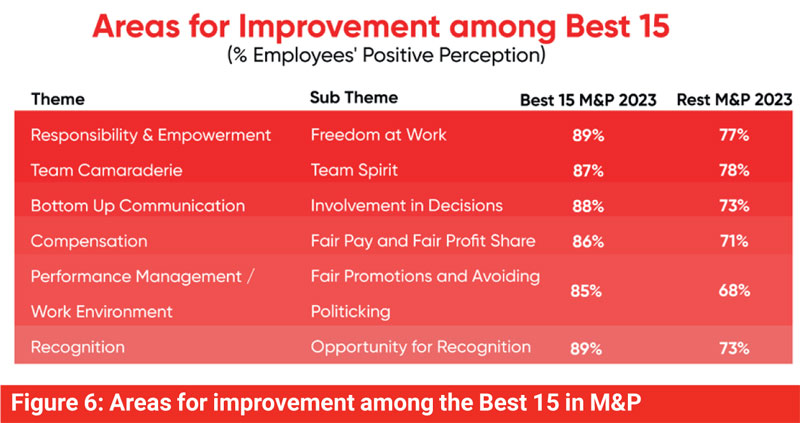
The No. 1 area to improve on is to allow employees greater freedom and empowerment in decisions that contribute to their work in an industry that is veritably driven top-down. While the Best certainly outperform the Rest in these areas, there is still much need for improving employee perception around fairness – the widest gaps are around equity and impartiality. This highlights the need for organisations to ensure all employee rewards are fairly linked to performance and all employees can contribute and have access to opportunities.
Conclusion
Locally and globally, the manufacturing and production industries have faced unprecedented challenges, exacerbated by a lingering pandemic, in-country economic, political, and societal challenges and geo-political conflicts that adversely impacted not only their daily routines but their profitability, ability to garner a share of the global wallets and retention of experienced and skilled staff that resulted in a brain-drain as not seen in the recent history of Sri Lanka.
Through it all however, the sector has stayed on course, managing its resources whether people, financial, property or intellectual and continued to serve the country’s economy while lobbying in the right places for relief measures to stay afloat. In these difficult times most of the M&P sector have ensured robust risk and governance measures, scaled down unnecessary spending, revamped in-house processes and structures and taken advantage of the ever-evolving digital platforms and transformative technology to enhance its capacities at lower costs. It is a testament of what having the right people in the right places can accomplish. The 15 Best Workplaces in manufacturing and production, though each on journeys of improvement of their own, demonstrate ROI in investing in people and culture.
The insights gathered by the Great Place to Work survey are a significant aid for employers to gather feedback and sustain people practices that drive business performance and competitiveness. The results have contributed to identifying areas for performance improvement within the sector and can be used to better articulate industry specific strategies, showcase competence and best practices and enhance investor attractiveness in the sector.
Great Place to Work’s mission is to help every workplace become a Great Place to Work For All so that organisations can maximise human potential through a High-Trust, High-Performance Culture that drives business, improves lives, and creates a better society. No matter where you are in your journey, you are invited to join in to discover and drive your employees’ positive perception and contribute to achieving the vision of making Sri Lanka a great place to work.
To better understand your organisation’s employee perception in general and to be in the running for the Best Workplaces Lists of 2023-24, contact Great Place to Work at +94 11 454 5594/0774100013 or visit www.greatplacetowork.lk for more information.
Discover Kapruka, the leading online shopping platform in Sri Lanka, where you can conveniently send Gifts and Flowers to your loved ones for any event including Valentine ’s Day. Explore a wide range of popular Shopping Categories on Kapruka, including Toys, Groceries, Electronics, Birthday Cakes, Fruits, Chocolates, Flower Bouquets, Clothing, Watches, Lingerie, Gift Sets and Jewellery. Also if you’re interested in selling with Kapruka, Partner Central by Kapruka is the best solution to start with. Moreover, through Kapruka Global Shop, you can also enjoy the convenience of purchasing products from renowned platforms like Amazon and eBay and have them delivered to Sri Lanka.
Discover Kapruka, the leading online shopping platform in Sri Lanka, where you can conveniently send Gifts and Flowers to your loved ones for any event including Valentine ’s Day. Explore a wide range of popular Shopping Categories on Kapruka, including Toys, Groceries, Electronics, Birthday Cakes, Fruits, Chocolates, Flower Bouquets, Clothing, Watches, Lingerie, Gift Sets and Jewellery. Also if you’re interested in selling with Kapruka, Partner Central by Kapruka is the best solution to start with. Moreover, through Kapruka Global Shop, you can also enjoy the convenience of purchasing products from renowned platforms like Amazon and eBay and have them delivered to Sri Lanka.